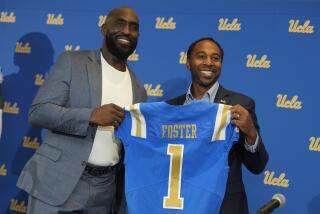NCAA Approves Academic Reforms
- Share via
Proclaiming a “sea change” in the direction of college sports, NCAA leaders passed legislation Thursday that for the first time threatens teams with stiff penalties when players stumble in the classroom.
The so-called incentives-disincentives program goes beyond the traditional practice of punishing the individual athlete and holds teams accountable by cutting their scholarships and excluding them from postseason play.
A football team with a low graduation rate, for example, would not be allowed to recruit as many high school players the following season. A basketball team with a low grade-point average could miss out on the lucrative “March Madness” tournament.
Taken in conjunction with rule changes last fall -- placing higher academic requirements on athletes -- Thursday’s vote puts on the books what NCAA President Myles Brand called “a critically important set of legislative measures, the strongest ever passed.”
But even as the NCAA Division I board of directors voted to approve the program at a meeting in Indianapolis, some in the academic world feared the association had not gone far enough.
“If meaningful reform were to come from this, that would be great,” said Ellen Staurowsky, a professor of sport management and media at Ithaca College in New York and a member of an academic group that has pushed for athletic reform.
“I do harbor some concerns,” she said. “We’re ratcheting up the pressure, but we haven’t really changed the way the system works.”
That system has come under increasing scrutiny, much of the criticism delivered by the high-powered Knight Foundation Commission on Intercollegiate Athletics in a 2001 report that decried “the widening chasm between higher education’s ideals and big-time college sports.”
The NCAA embarked on a three-year effort that culminated with the new legislation.
Last fall, the association enacted tougher requirements for entering freshmen and mandated that, once in school, athletes must complete 20% of the classwork required for graduation each year, keeping them on track to earn a degree in five years.
Thursday’s vote established an “academic-progress rate” that puts pressure on teams to be sure their players meet these requirements.
Teams will earn points for each athlete who remains eligible from one semester to the next. Graduation rates will also factor into the equation.
An NCAA committee will set a minimum acceptable score.
Drawing this “cut rate” will not be easy. The NCAA will spend the next two years compiling data to determine a universal standard that applies to an array of sports and campuses -- in other words, something that works for both the Stanford women’s golf team and the Cal State Northridge baseball team.
Though the cut rate will not be enforced until the 2006-07 school year, schools will be advised this fall as to how they compare.
“If you’re at the bottom of the list, you’ve got some work to do,” NCAA spokesman Jeff Howard said.
Starting in fall 2006, teams falling short of the cut rate will receive warnings. The ensuing year, they face recruiting limitations and the loss of scholarships.
By 2008-09, teams with chronically bad scores can be denied postseason play and eventually banished from the NCAA.
In addition, starting in fall 2005, teams below the cut rate will lose a scholarship for one year for every athlete who leaves school in poor academic standing.
The new program could change the way college coaches do their jobs, an administrator at a Southern California university said.
“It’ll put a lot more emphasis on how you recruit and the kind of kids you recruit,” said Brian Quinn, the Cal State Fullerton athletic director. “We’ll have to do more to find the kind of kids we know are able to come in and do well in school.”
The message to athletes was simple, said Robert Hemenway, the University of Kansas chancellor and chairman of the NCAA board of directors: “If you come to our institutions, we’re going to do everything in our power to make sure you graduate.”
But Staurowsky and others in her organization, the Drake Group, say they worry the reforms fail to address the roots of the problem.
Long hours of practice and travel to road games still eat away at study time, she said. Athletic departments still spend millions on new facilities and high-priced coaches, meaning they must sell tickets and attract television coverage to pay debts.
“If there’s still so much pressure to win, then what kinds of protections are there that we’re not going to see an increasing amount of academic fraud?” she asked.
As Quinn, the Cal State Fullerton administrator, said: “You can put in rule after rule after rule and the cheaters will still cheat.”
Brand said the NCAA was aware of this risk and has increased its investigative staff from 12 to 18 to ferret out cases of improper grades.
Brand, the former Indiana University president best known as the man who fired mercurial basketball coach Bobby Knight, has been a vocal proponent for change in college sports.
This stance has garnered respect, if not total confidence, from those in the reform movement.
“I think he is making a valorous effort to right the ship,” Staurowsky said. But, she added, “I think he has inherited an extremely difficult problem.”
Having won a vote Thursday for the new academic program, Brand said he was looking to build momentum by turning his sights to concerns that universities were spending too much money on sports.
Hemenway was equally hopeful, saying: “This is a very significant day in the history of the NCAA.”
*
Times staff writer Eric Stephens contributed to this report.
More to Read
Go beyond the scoreboard
Get the latest on L.A.'s teams in the daily Sports Report newsletter.
You may occasionally receive promotional content from the Los Angeles Times.











